LONGER TRANSACTIONAL TEXTS GRADE 12 NOTES - LITERATURE STUDY GUIDE
Share via Whatsapp Join our WhatsApp Group Join our Telegram Group- Steps to writing longer transactional texts in the exams
- Category A
- Formal letter
- Informal or friendly letter
- Formal and informal letter to the press
- Category B
- Curriculum vitae (CV) and covering letter
- Obituary
- Category C
- Review
- Newspaper article
- Magazine article
- Agenda and minutes of a meeting
- Formal and informal report
- Category D
- Dialogue
- Written interview
- Written formal and informal speech
- What is expected from you in the exam?
Section B: Longer transactional texts
A transactional text is a written exchange of information, or a written record of communication between people. This type of writing has a specific purpose and format, such as conducting business, or sharing news.
In this section, you will learn the features of each type of longer transactional text that will earn you marks in the final Grade 12 exam.
There are four categories of longer transactional text.
1. Steps for writing longer transactional texts
There are four main steps for writing a longer transactional text in an exam:
Step 1: Choose your text type
Step 2: Plan your topic
Step 3: Write a draft of your text and edit it
Step 4: Write your final text
Step 1: Choose your text type and topic
There are four categories of longer transactional texts. The exam has one question for each of these four categories. You only have to answer ONE of the questions. Choose the text type format you know best.
Longer transactional texts | |
Category A |
|
Category B | 4. CV and covering letter |
Category C | 6. Review |
Category D | 11. Dialogue |
Hint:
|
Step 2: Plan your topic
Remind yourself of the correct format for the text type you have chosen.
Plan your text by writing down your ideas for the content. Remember that your ideas must be relevant to the topic, and the text type you have chosen.
There are many different ways to plan your text. For example, you could use a mind map. Use the planning method that works best for you. There are examples of planning tools on page 46.
Once you have written down a few ideas, you can organise them by numbering them in a logical order. This is the order in which you will structure your ideas in paragraphs in your text.
Logical order - Arranging information so that the points follow each other in an order that makes sense.
Hint:
|
Ways to plan a longer transactional text
A plan helps you think about what ideas you want to include in your text. It also helps you put your ideas into a clear structure. You will earn marks for showing your planning.
You can use a mind map or an ideas list to plan your text.
1. Mind maps
These are diagrams of ideas. The title is in the centre with branches coming from it showing thoughts and ideas. Below is an example of a mind map.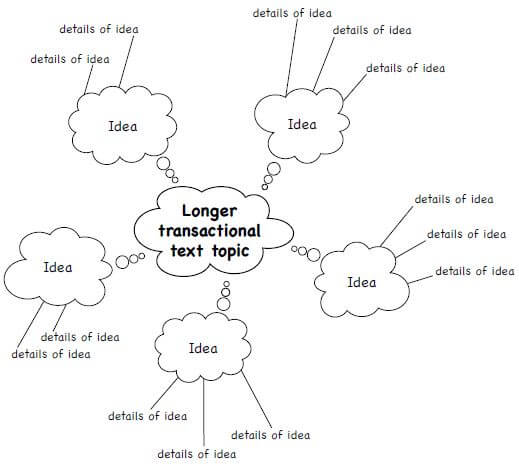 2. Idea lists
2. Idea lists
These help you to quickly write down ideas for each paragraph. Your idea list can be a random or a numbered list. Below are examples of these two different idea lists.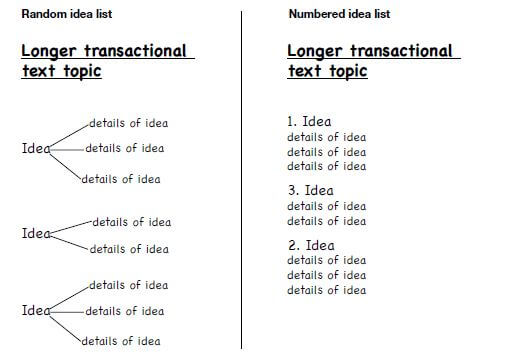 Step 3: Write and edit your draft text
Step 3: Write and edit your draft text
Write a draft of your text, using the ideas from your plan.
Check that the format is right for the text type you have chosen.
Read through each sentence carefully to proofread it. Look for any spelling, punctuation or other language mistakes. Edit your draft by correcting these mistakes and making any other changes you think are needed. This will improve your final text.
Count the number of words in your text and make any changes to meet the word limit. For example, you may need to add some words or use fewer words.
Note - The content of a longer transaction text is between 120-150 words long. In a letter do not add the address and greetings as part of the word count.
Hint:
|
Step 4: Write your final text
Write your final text by rewriting your draft. Make sure that you make all the changes you marked in your draft so that your final text has no mistakes and clearly expresses all your best ideas. Check again that the text is in the correct format for the text type.
When you have finished your final text, cross out your planning and draft text. If you do not do this, the examiner may mark your draft and not your final text.
Hint:
|
Important differences between formal and informal writing
Formal writing | Informal writing |
|
|
|
|
|
|
|
|
|
|
2. Category A
Category A in the exam paper covers the following:
- Formal letter
- Informal or friendly letter
- Formal and informal letter to the press
Each one of these letters has a different format, serves a different purpose and has a different register. For example, the register of a letter to a place of business is formal, while the register of a letter to a friend is informal.
2.1 Writing a formal letter
A formal letter is a communication used in official or important situations, or with people you do not know well.
Hint;
|
eg: A learner’s example of a formal letter using the four steps
Step 1: Choose the text type and topic
This learner chose this question on a formal letter:
An international company is offering a limited number of bursaries to Grade 12 learners for further studies.
Write a letter to the Manager: Human Resources of this company, applying for one of these bursaries. Mention the career you want to study towards and state clearly why you deserve this bursary.
Step 2: Plan the text
Read through the question carefully and look for the key words that would help you think about the contents of your letter. Note these key words in the question above: bursaries, career and deserve this bursary.
The learner used a mind map to plan her formal letter.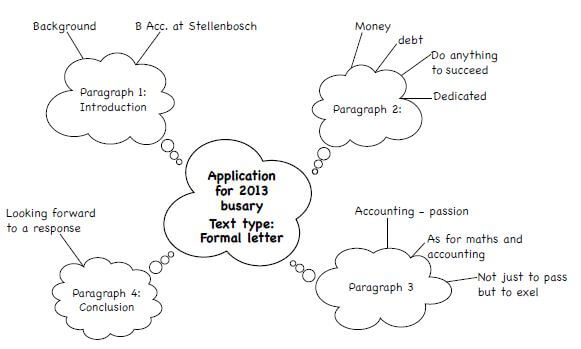
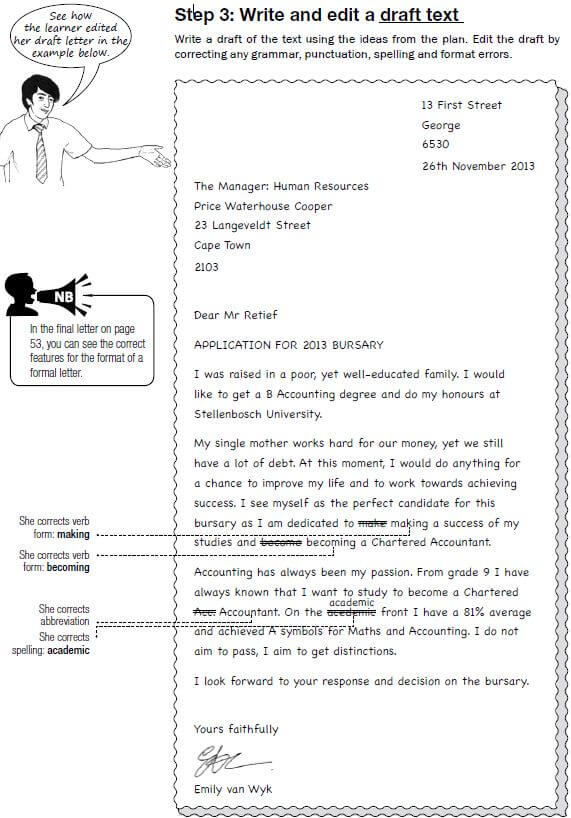
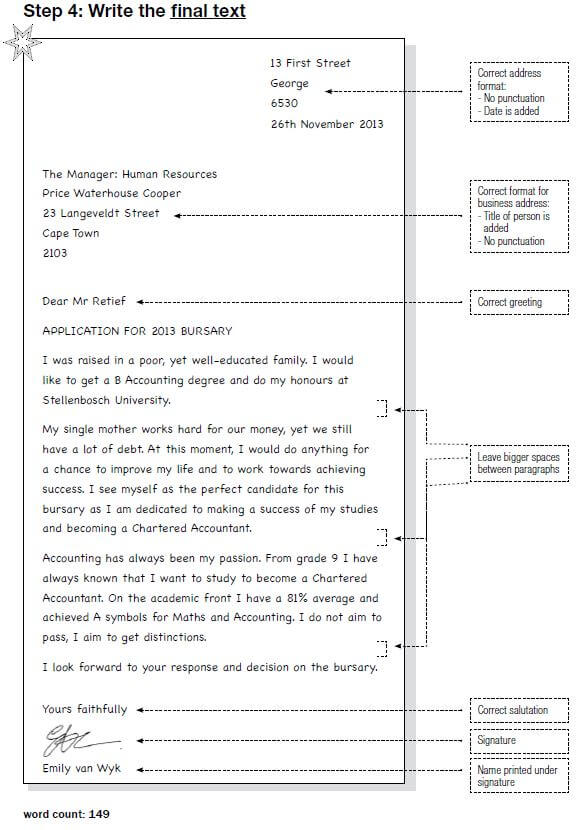
Activity: Writing a formal letter
Here are some formal letter topics to help you to practise your writing skills:
- Recently your youth club/religious organisation hosted a successful sports day for your community. A local company sponsored prizes for the event.
You are the chairperson of the organising committee of this event. Write a letter to the manager of the company, telling him/ her about the success of the event and thanking him/her for the sponsorship.
Note - in question 1 there are two things you must do in your letter: Talk about the success of the event and thank the chairperson for sponsoring the event. - Recently you needed a certain item which you were unable to obtain from stores in your area. However, a shop assistant at a certain store helped you to obtain the item.
Write a letter to the manager of that store, giving details about
how the shop assistant helped you and expressing your gratitude.
2.2 Writing an informal letter
An informal letter also called a friendly letter is usually written to friends or family members.
Hint:
|
eg: A learner’s example of an informal letter using the four steps
Step 1: Choose the text type and topic
This learner chose this question on an informal or friendly letter:
Your friend has experienced a major disappointment. At the moment he/she is very depressed.
Write a letter to encourage and support your friend.
Step 2: Plan the text
Read the question carefully and find the key words in the question to help
you think of the contents of the letter.
Note the words disappointment and depressed and encourage and support in the question above. The learner used these key words in the mind map to plan his friendly letter.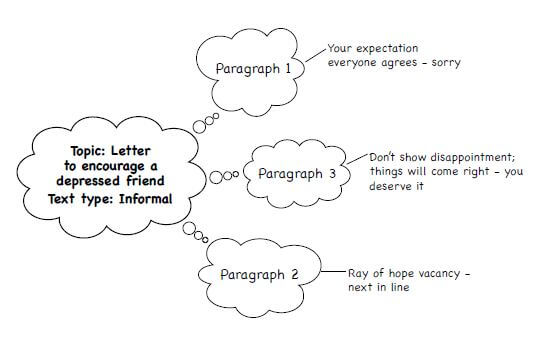
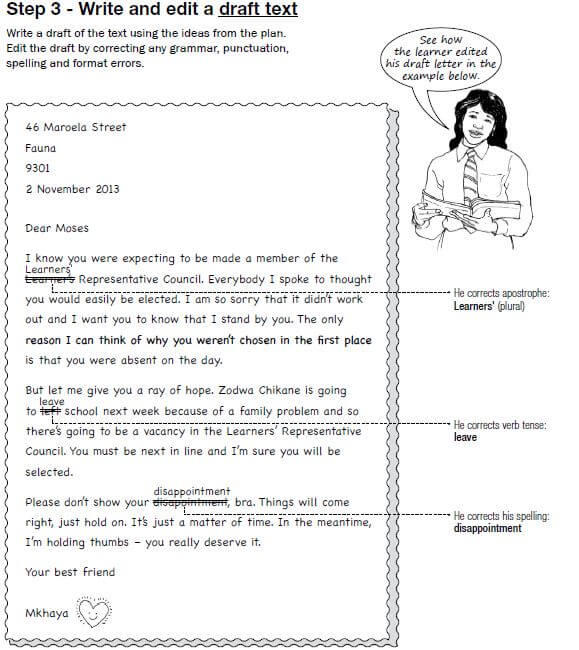
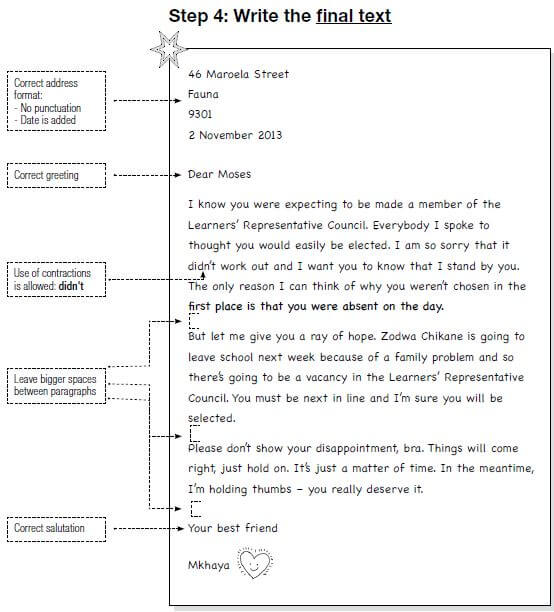
Word count: 146
Activity: Writing an informal letter
Here are some informal letter topics to help you to practise your writing skills:
- Your best friend has been selected to represent the province in a certain code of sport.
Write a letter to congratulate him/her on this achievement and to wish him/her well. - You have won two tickets to a soccer/rugby/cricket match in another province.
Write a letter inviting a friend to accompany you. Include details such as travel and accommodation arrangements.
2.3 Writing a letter to the press
A letter to the press (such as newspapers) is a formal letter with its own features and format rules.
Hint:
|
eg: A learner’s example of a letter to the press using the four steps
Step 1: Choose the text type and topic
The learner chose to write this letter to the press in the exam:
Respond to a letter in your local newspaper. In this letter a reader argues that the death penalty should be re-introduced.
Take a position in which you either support or reject the reader’s views.
Step 2: Plan the text
Find the key words in the question to help you think of the contents of the letter. The key words in this question are death penalty and support or reject.
The learner has used a list to plan her letter.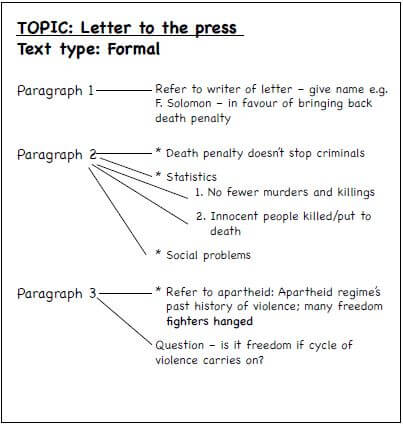
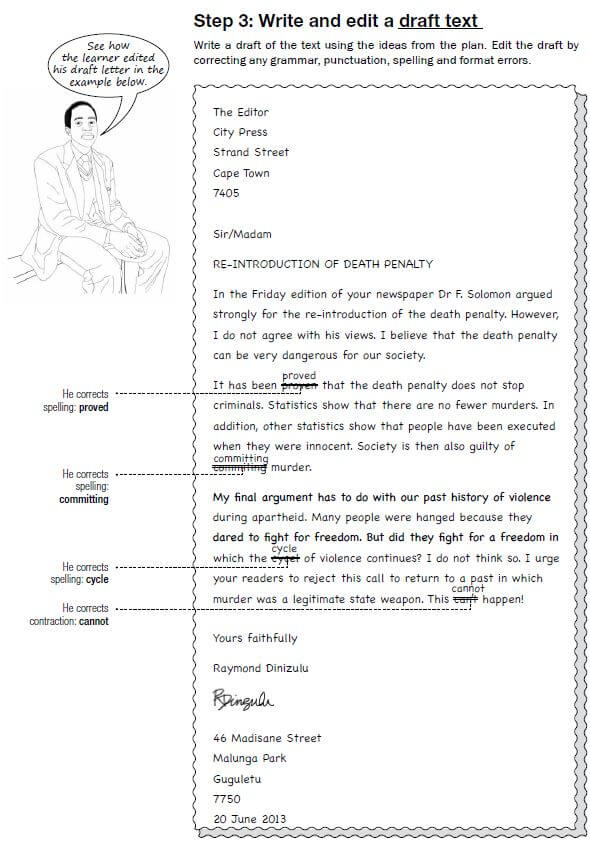
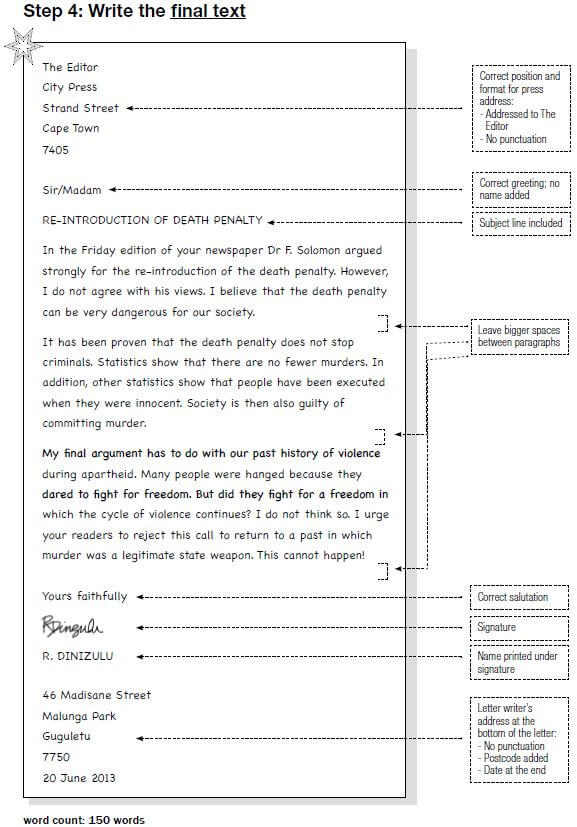
Activity: Writing a letter to the press
Here are some letter to the press topics to help you to practise your writing skills:
- Write a letter to the press in which you support or disagree with raising the age at which a person can obtain a driver’s licence from 18 to 21.
- Write a letter to the press in which you take a stand on the issue of violence against women. Propose a way of dealing with people who abuse women.
2.4. Category A checklist
Features | Details of the feature | Yes | No | Don't know |
Exam instructions | I understand the exam instruction for writing a letter | |||
Letter topic | I understand the letter topic I have chosen. | |||
Letter type | I understand the features of the letter type I have chosen:
| |||
Content, planning and format | ||||
Planning | I can show evidence of planning my letter. | |||
Content | Each point in my plan is relevant to the letter topic. | |||
Purpose/audience | I understand the purpose of the letter type I have chosen | |||
Letter structure | The first paragraph of my letter introduces the topic. The paragraphs in the body of my letter relate to the topic. The last paragraph concludes the ideas in my letter. | |||
Sentences | I have not repeated sentences in my paragraphs. | |||
Paragraphs | My ideas link and are well-organised in paragraphs. | |||
Format | I have used the correct format for the type of letter I have chosen:
| |||
Language, style and editing | ||||
Choice of words/diction | I have chosen my words carefully to make my letter interesting. My letter has the correct register (formal or informal) for the type of letter i have written. | |||
Verb tenses | I have used tenses correctly (past, present or future). | |||
Concord | My nouns and verbs are in agreement. | |||
Spelling | My spelling is correct. | |||
Punctuation | My sentences start with a capital letter and end with a punctuation mark. | |||
3. Category B
Category B in the exam covers the following:
- Curriculum vitae (CV) and covering letter
- Obituary
Each of these texts has a different format, serves a different purpose and has a different register.
3.1 Writing a CV
A CV is the document you send to businesses when you are applying for a job. It briefly shows the potential employer important information about you, and why you are suitable for the job. This information includes details about your education, qualifications, and previous work experience.
A covering letter is a letter which you send with your CV when applying for a job. A well-written covering letter will improve your chances of being given the job.
Hint:
|
eg: A learner’s example of a CV using the four steps
Step 1: Choose the text type and topic
This learner chose this question on a CV:
You are applying for a job at a supermarket. Write the CV that you will submit. It is not necessary to write a covering letter.
Step 2: Plan the text
Look for the key words in the question that would help you with the content. In the question above, the key words are apply for a job and supermarket. The learner used a mind map to plan his CV.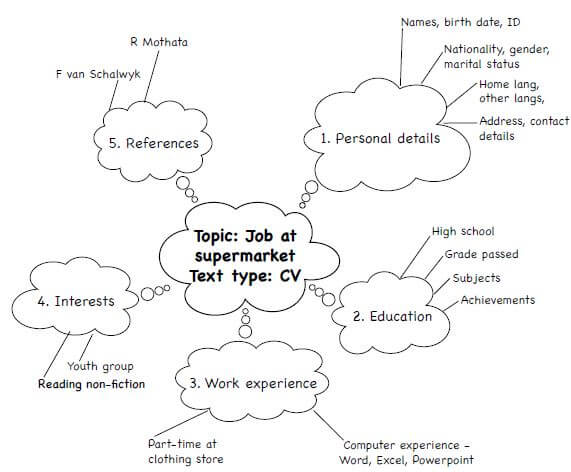
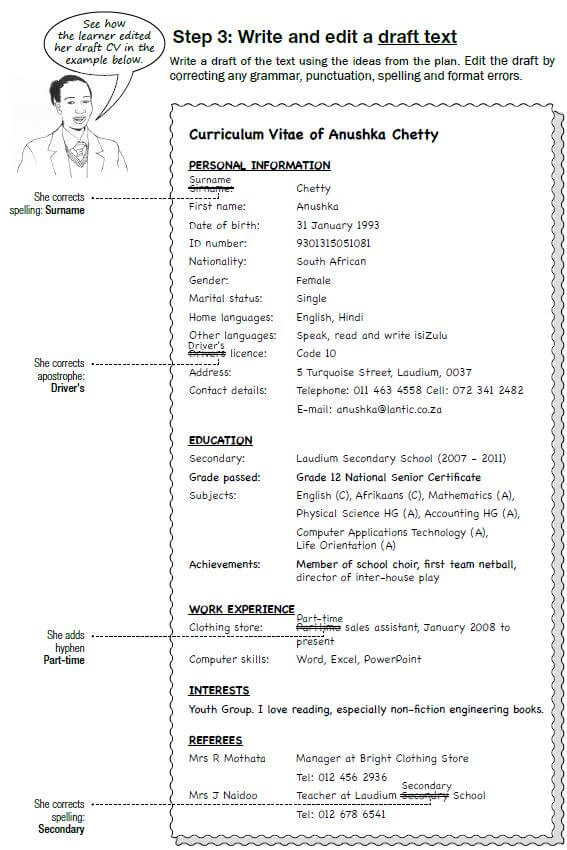
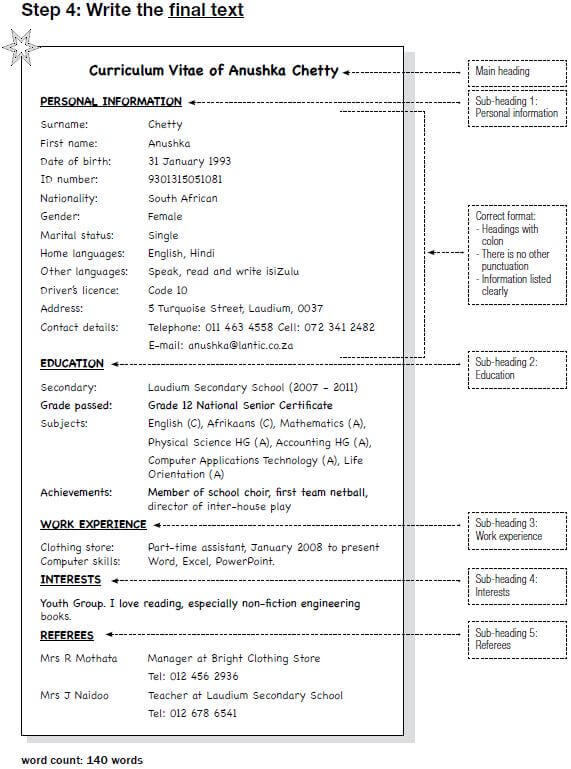
Activity: Writing a CV
Here are some CV topics to help you to practise for the exam:
- You are in your final year of Grade 12. You intend applying for part-time work. Write the CV that will accompany your application.
- You have recently completed a Bachelor of Arts degree in journalism. You have applied for a job at a local newspaper as a journalist. Write the CV that will accompany your application.
3.2 CV checklist
Features | Details of the feature | Yes | No | Don't know |
Text type | I understand the features of a CV and covering letter. | |||
Topic | I understand the topic I have chosen. | |||
Content, planning and format | ||||
Planning | I can show evidence of planning. | |||
Content | Each point in plan is relevant to my topic. | |||
Purpose / Audience | I understand the purpose of a CV and covering letter. | |||
Format | My CV is correctly laid out:
My covering letter uses the correct formal letter features. | |||
Language, style and editing | ||||
Choice of words / diction | I have chosen my words carefully to make my CV and covering letter informative and clear. | |||
Language | I have checked and corrected my grammar, spelling and punctuation. | |||
3.3 Writing an obituary
An obituary is a text about a person who has recently died. It may be published as an article in a newspaper, or read aloud at a funeral.
Hint:
|
eg: A learner’s example of an obituary using the four steps
Step 1: Choose the text type and topic
This learner chose this question on an obituary:
A well-known person in your community has passed away. This person was actively involved in charity work.
Write a suitable obituary, paying tribute to the person.
Step 2: Plan the text
Read the question carefully and note the key words that would help you brainstorm the content of your answer. In the question above, the key words are well-known in your community and charity work.
This learner has used a mind map to plan her essay.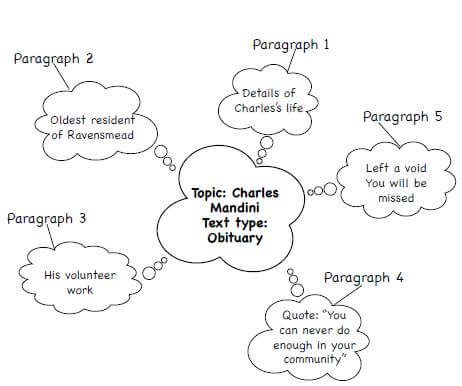
Step 3: Write and edit a draft text
Write a draft of the text using the ideas from the plan.
Edit the draft by correcting any grammar, punctuation, spelling and format errors.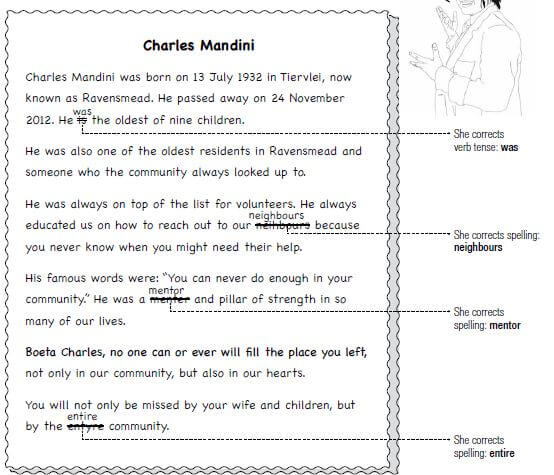
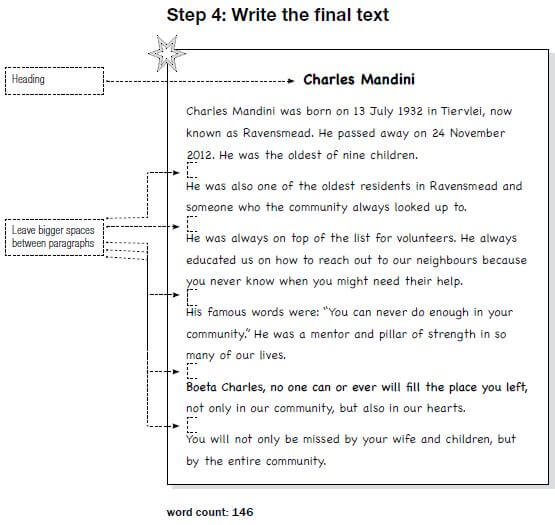
Activity: Writing an obituary
Here are some topics to help to practise writing obituaries:
- A well-known member of your church has died. He/she was responsible for looking after the youth, and frequently helped boys and girls who were in trouble. Write the obituary for this person.
- A respected and favourite teacher has died. The principal has approached you as a member of the Learners’ Representative Council to write an obituary. Write the obituary for this teacher.
3.4. Obituary checklist
Features | Details of the feature | Yes | No | Don't know |
Text type | I understand the features of an obituary. | |||
Topic | I understand the topic I have chosen. | |||
Content, planning and format | ||||
Planning | I can show evidence of planning. | |||
Content | Each point in plan is relevant to my topic. | |||
Purpose / Audience | I understand the purpose of an obituary. | |||
Format | My obituary. is correctly laid out:
| |||
Language, style and editing | ||||
Choice of words / diction | I have chosen my words carefully to make my obituary interesting. | |||
Language | I have checked and corrected my grammar, spelling and punctuation. | |||
4. Category C
Category C in the exam covers the following texts:
- Review
- Newspaper article
- Magazine article
- Agenda and minutes of a meeting
- Formal report
Each one of these texts has a different format, serves a different purpose and has a different register.
4.1 Writing a review
A review is a written assessment or account of something. Reviews may be assessments of an artwork; a movie; a book; a restaurant; a performance (a play or a concert); a CD or DVD; or a place.
Hint:
|
eg: A learner’s example of a review using the four steps
Step 1: Choose the text type and topic
This learner chose this question on a review:
Write a review of one of your literature setworks.
Step 2: Plan the text
The learner decided to write a review of Nothing But the Truth, and used a mind map to plan his review.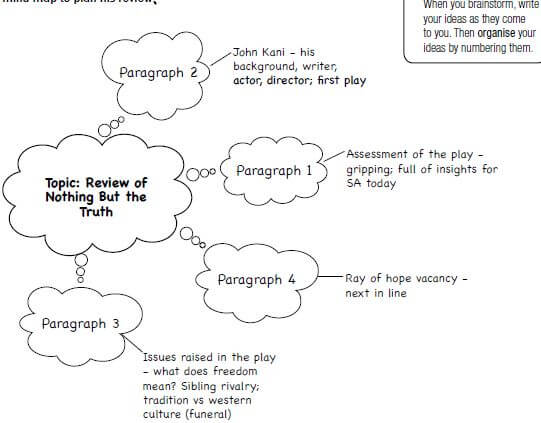
Step 3: Write and edit a draft text
Write a draft of the text using the ideas from the plan. Edit the draft by correcting any grammar, punctuation, spelling and format errors.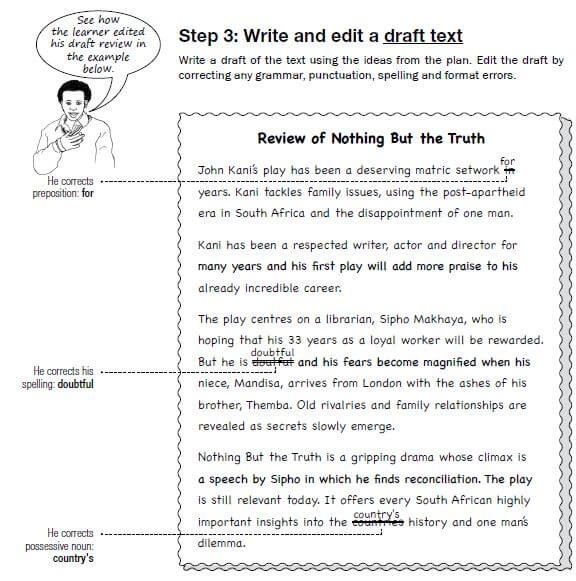
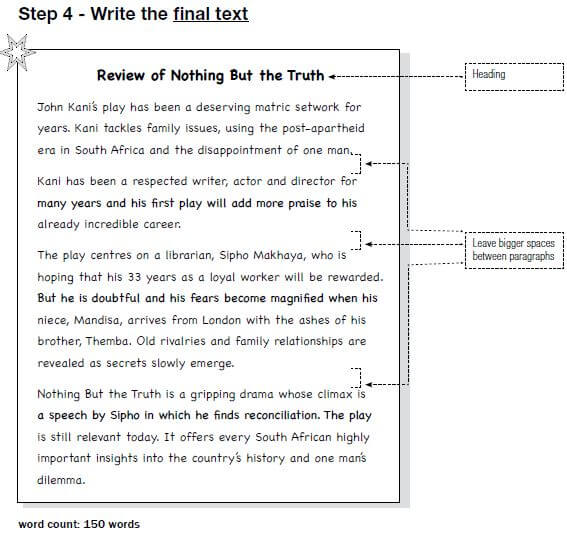
Activity: Writing a review
Here are some topics to help you to practise writing reviews:
- Your high school puts on a play every year. You are a member of the school’s annual magazine committee and have been asked to write a review of this production. Write this review.
- Your family often visits a nearby restaurant. A local newspaper is holding a competition for its readers in which they are asked to submit a review. You decide to submit a review of this restaurant.
- Write a review of your favourite movie / TV series / radio programme.
4.2 Review checklist
Features | Details of the feature | Yes | No | Don't know |
Text type | I understand the features of a review | |||
Topic | I understand the topic I have chosen. | |||
Content, planning and format | ||||
Planning | I can show evidence of planning. | |||
Content | Each point in plan is relevant to my topic. | |||
Purpose / Audience | I understand the purpose of a review. | |||
Format | My review is correctly laid out:
| |||
Language, style and editing | ||||
Choice of words / diction | I have chosen my words carefully to make my review interesting. | |||
Language | I have checked and corrected my grammar, spelling and punctuation. | |||
4.3 Writing a newspaper article
A newspaper article is a piece of writing in a newspaper about a particular subject. Its purpose is to inform or entertain the public.
Hint:
|
eg: A learner’s example of a newspaper article using the four steps
Step 1: Choose the text type and topic
This learner chose this question on a newspaper article:
There has been an increase in various types of crime in your area.
Write an article for publication in your local newspaper suggesting ways to avoid becoming a victim of crime.
Step 2: Plan the text
Identify the key words to use in your planning - local newspaper and victim of crime. Then order your ideas logically. The learner used a list to plan her newspaper article.
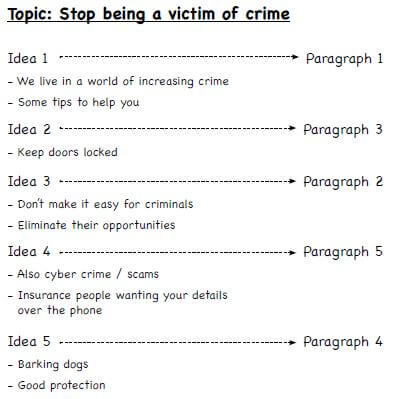
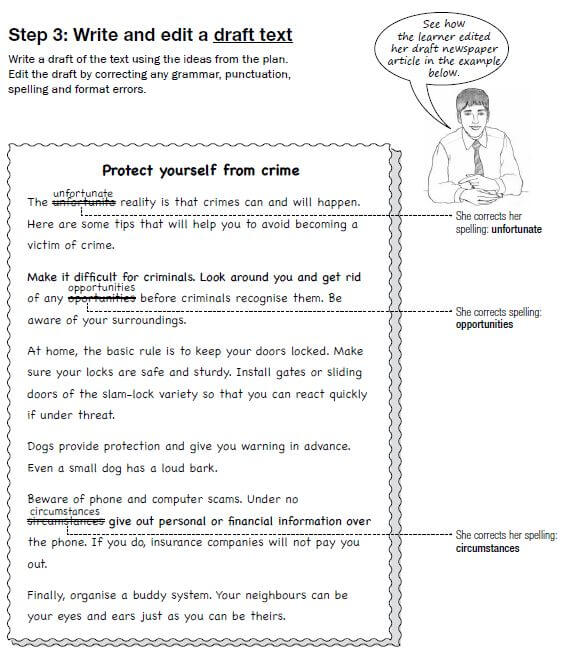
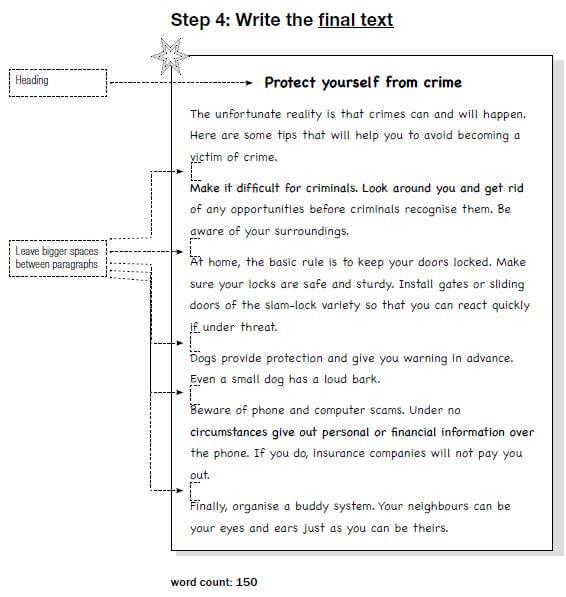
Activity: Writing a newspaper article
Here are some topics to help you to practise writing newspaper articles:
- The local newspaper has approached you as a learner in Grade 12 at the local high school. The newspaper would like you to write an article on the pressure of final examinations. Write this article.
- An intersection near your house is very dangerous and a number of accidents have occurred there. Your local newspaper has asked you to write an article for the newspaper about this problem.
- Write a newspaper article using this headline: Bullying on the increase in local school.
4.4 Newspaper article checklist
Features | Details of the feature | Yes | No | Don't know |
Text type | I understand the features of a newspaper article. | |||
Topic | I understand the topic I have chosen. | |||
Content, planning and format | ||||
Planning | I can show evidence of planning. | |||
Content | Each point in plan is relevant to my topic. | |||
Purpose / Audience | I understand the purpose of a newspaper article. | |||
Format | My newspaper article is correctly laid out:
| |||
Language, style and editing | ||||
Choice of words / diction | I have chosen my words carefully to make my newspaper article interesting. | |||
Language | I have checked and corrected my grammar, spelling and punctuation. | |||
4.5 Writing a magazine article
A magazine article is a piece of writing in a magazine about a particular subject. Like a newspaper article, it aims to entertain and inform the reader.
There are different kinds of magazine articles. Some give opinions. Some give advice. Some just present facts. Read the question carefully to make sure you write the right kind of article.
Hint:
|
eg: A learner’s example of a magazine article using the four steps
Step 1: Choose the text type and topic
This learner chose this question on a magazine article:
You are a committee member of your school magazine.
Write an article covering the sporting highlights of 2013.
Step 2: Plan the text
Identify the key words to use in your planning. In the question above,
the key words are school magazine and sporting highlights. The learner used a mind map to plan his magazine article.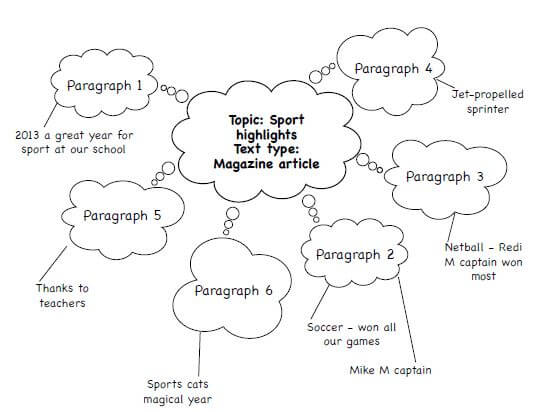
Step 3: Write and edit a draft text
Write a draft of the text using the ideas from the plan. Edit the draft
by correcting any grammar, punctuation, spelling and format errors.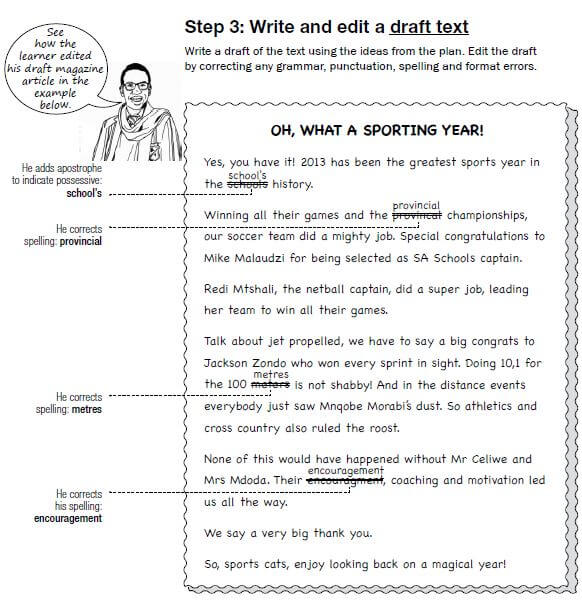
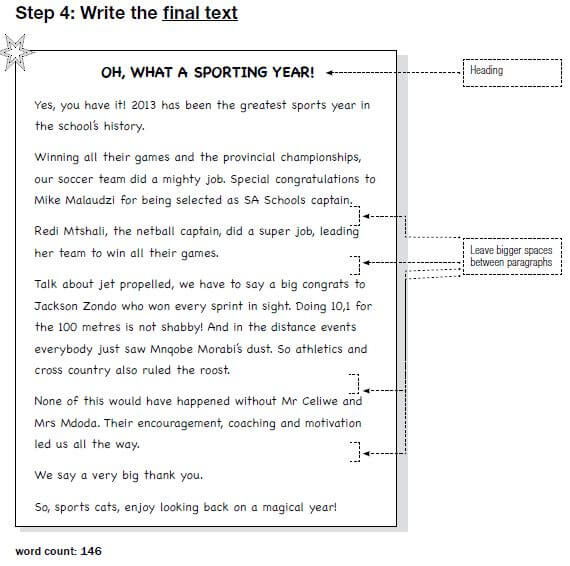
Activity: Writing a magazine article
Here are some topics to help you to practise writing magazine articles:
- You have been approached by the editor of a teenage magazine to write an article on peer pressure. Your focus should be on its effects and how to deal with it. Write this article.
- You work on a part-time basis for a small teenage magazine. Your next assignment is to write on changing teenage fashion trends. Write this article.
- Many young people overcome difficult circumstances. Write a magazine article about one such person, either real or imaginary.
4.6 Magazine article checklist
Features | Details of the feature | Yes | No | Don't know |
Text type | I understand the features of a magazine article. | |||
Topic | I understand the topic I have chosen. | |||
Content, planning and format | ||||
Planning | I can show evidence of planning. | |||
Content | Each point in plan is relevant to my topic. | |||
Purpose / Audience | I understand the purpose of a magazine article. | |||
Format | My magazine article is correctly laid out:
| |||
Language, style and editing | ||||
Choice of words / diction | I have chosen my words carefully to make my magazine article interesting. | |||
Language | I have checked and corrected my grammar, spelling and punctuation. | |||
4.7 Writing an agenda and minutes of a meeting
An agenda is a list of the subjects that will be discussed, as well as the procedure that will be followed, at a meeting. The agenda is prepared before the meeting.
Minutes are a written record of what was discussed and decided at a meeting. Minutes are recorded as a meeting is happening.
Hint:
|
eg: A learner’s example of an agenda and minutes using the four steps
Step 1: Choose the text type and topic
This learner chose this question on an agenda and minutes:
You are the secretary of your school’s Learners’ Representative Council. Write the agenda and minutes of a meeting in which the Council discussed latecomers.
Step 2: Plan the text
Identify the key words to use in your planning. In the question above, the key words are Learners’ Representative Council, agenda, minutes and latecomers.
The learner used a list to plan her agenda and minutes.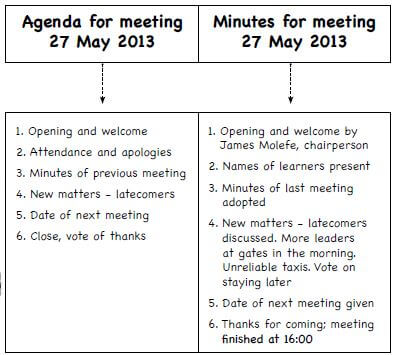
Step 3: Write and edit a draft text
Write a draft of the text using the ideas from the plan. Edit the draft by correcting any grammar, punctuation, spelling and format errors.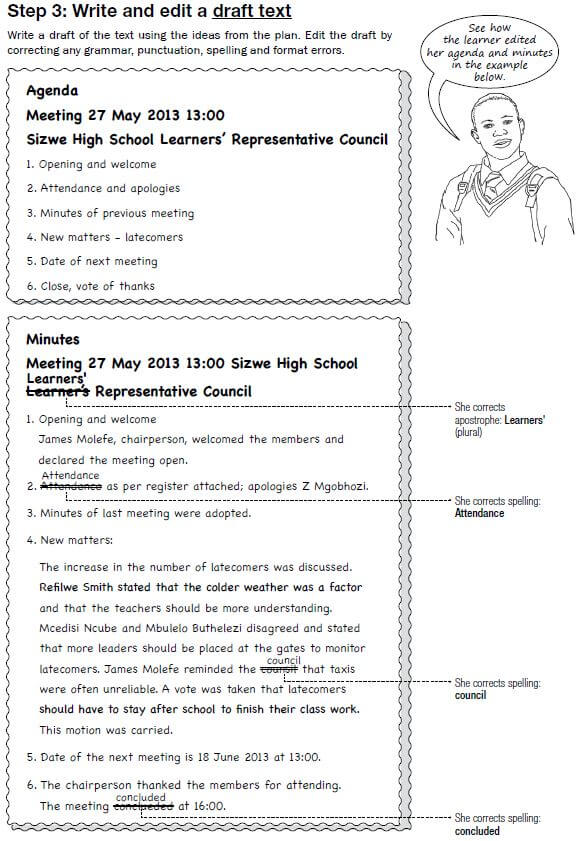
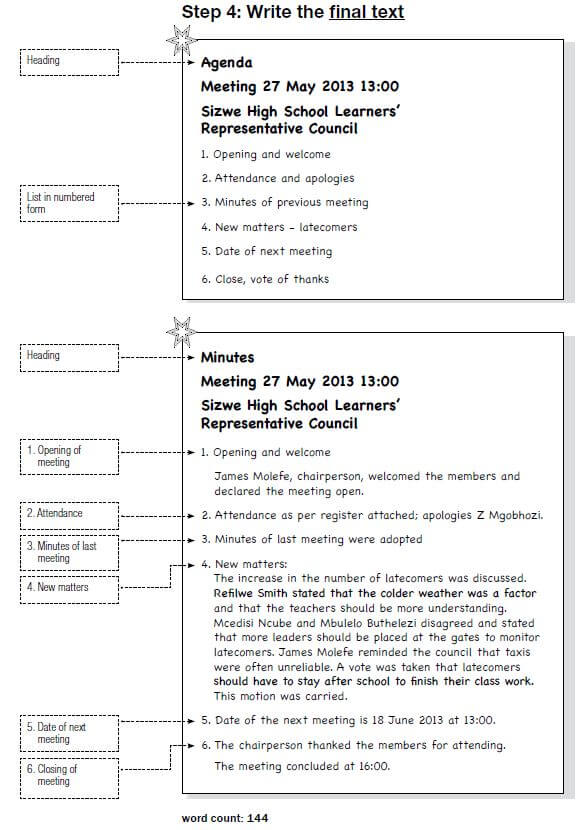
Activity: Writing an agenda and minutes
Here are some topics to help you to practise writing an agenda and minutes:
- As the chairperson of the Matric Committee, it is your task to organise the farewell assembly for the Grade 12s. You call a meeting of all the matrics and discuss this matter, taking various decisions. Write the agenda and minutes of this meeting
- You belong to a soccer / netball / athletics club. The next meeting of the committee is due to take place. Two issues are on the agenda: an increase in subscription fees, and the need to expand the clubhouse. Write the agenda and minutes of this meeting.
4.8 Agenda and minutes of a meeting checklist
Features | Details of the feature | Yes | No | Don't know |
Text type | I understand the features of an agenda and minutes. | |||
Topic | I understand the topic I have chosen. | |||
Content, planning and format | ||||
Planning | I can show evidence of planning. | |||
Content | Each point in plan is relevant to my topic. | |||
Purpose / Audience | I understand the purpose of an agenda and minutes. | |||
Format | My agenda and minutes are correctly laid out:
| |||
Language, style and editing | ||||
Choice of words / diction | I have chosen my words carefully to make my agenda and minutes accurate and informative. | |||
Language | I have checked and corrected my grammar, spelling and punctuation. | |||
4.9 Writing a formal report
A formal report is a written description of a situation or event after an investigation. Formal reports contain information and ideas that can help to resolve difficult situations.
Hint:
|
eg: A learner’s example of a formal report using the four steps
Step 1: Choose the text type and topic
This learner chose this question on a formal report:
You are the captain of a popular sporting code at your school. Your team participated in an interschool event during which one of your team members was seriously injured. Your school principal has requested a formal report from you on the incident and the action taken afterwards.
Write the report you will submit.
Step 2: Plan the text
Identify the key words to use in your planning. In the question above, the key words are interschool event, team member injured and action taken afterwards.
The learner has used a mind map to plan his report.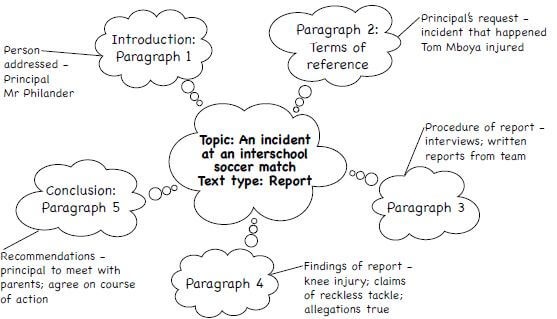
Step 3: Write and edit a draft text
Write a draft of the text using the ideas from the plan. Edit the draft by correcting any grammar, punctuation, spelling and format errors.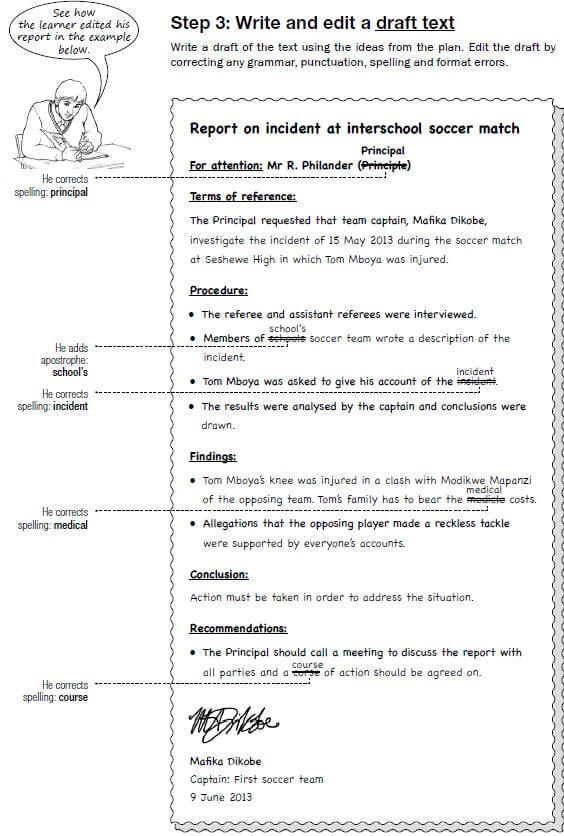
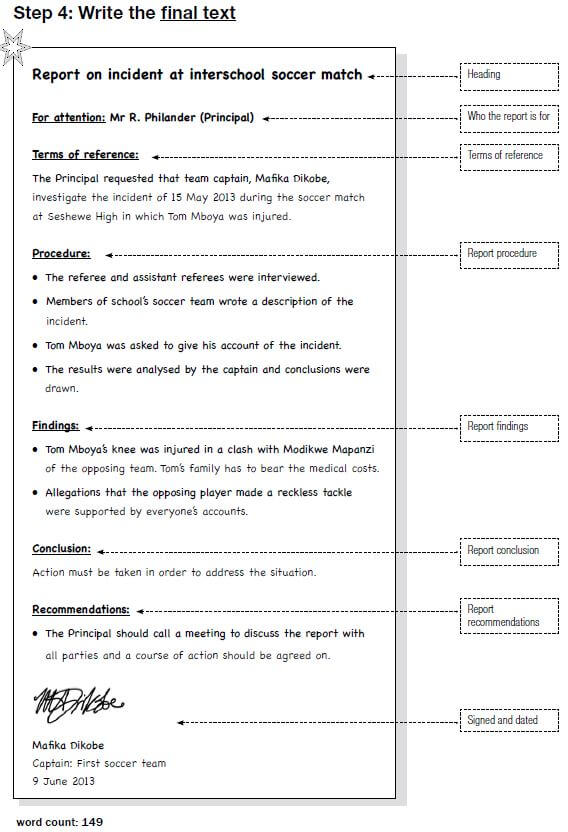
Activity: Writing a formal report
Here are some topics to help you to practise writing formal reports:
- There have been complaints at school that the prices charged by the tuckshop for food and cold drinks are too high.
The Deputy Principal has asked you to investigate this situation. Write the report that you will submit. - You belong to a community club for the youth. Recently attendance at club events has dropped considerably.
The youth leader, Mr N. Sithole, has asked you to investigate reasons for this situation. Write the report that you will submit.
4.10 Formal report checklist
Features | Details of the feature | Yes | No | Don't know |
Text type | I understand the features of a formal report. | |||
Topic | I understand the topic I have chosen. | |||
Content, planning and format | ||||
Planning | I can show evidence of planning. | |||
Content | Each point in plan is relevant to my topic. | |||
Purpose / Audience | I understand the purpose of a formal report. | |||
Format | My formal report is correctly laid out:
| |||
Language, style and editing | ||||
Choice of words / diction | I have chosen my words carefully to make my newspaper article interesting.report accurate and informative. | |||
Language | I have checked and corrected my grammar, spelling and punctuation. | |||
5. Category D
Category D in the exam paper covers the following:
- Dialogue
- Written interview
- Written formal and informal speech
Each one of these texts has a different format, serves a different purpose and has a different register.
5.1 Writing a dialogue
A dialogue is a conversation between two or more people. The people speak about a specific topic.
Hint:
|
eg: A learner’s example of a dialogue using the four steps
Step 1: Choose the text type and topic
This learner chose this question on a dialogue:
A close friend has upset you in some way. Write out the dialogue that takes place between you and your friend, in which you discuss with him/her what he/she has done to upset you.
Note: Use the dialogue format.
Step 2: Plan the text
Identify the key words to use in your planning. In the question above, the key words are close friend, upset and discuss.
The learner used a list to plan her dialogue.
Topic: Argument between friends
|
Step 3: Write and edit a draft text
Write a draft of the text using the ideas from the plan. Edit the draft by correcting any grammar, punctuation, spelling and format errors.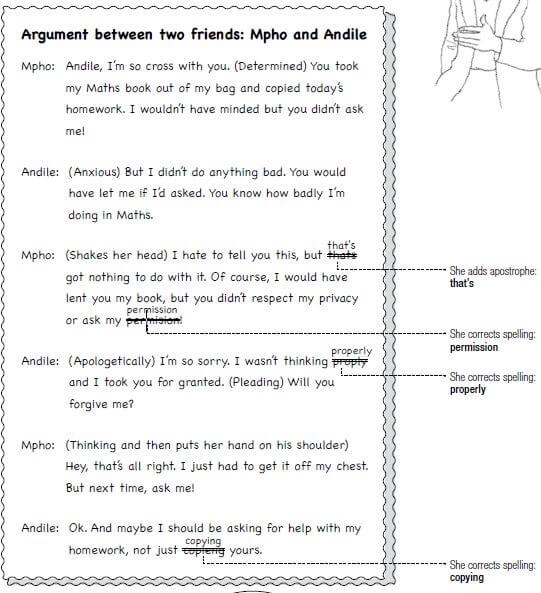
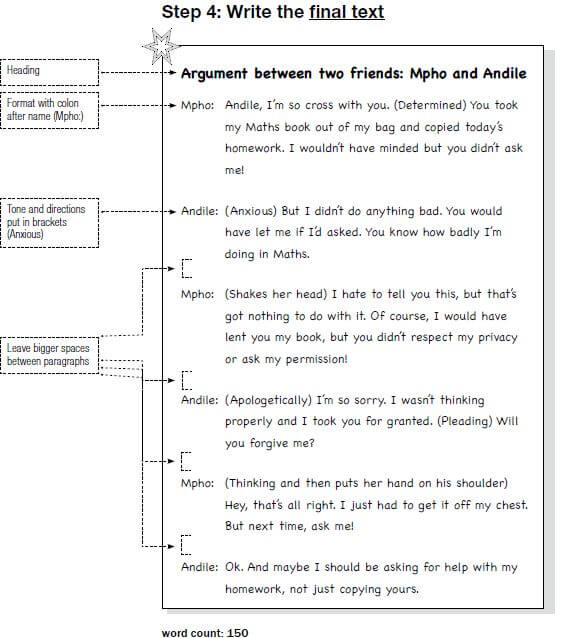
Activity: Writing a dialogue
Here are some topics to help you to practise writing dialogues:
- Eleni and Precious are good friends. However, Precious is going to “bunk” a Science class because she does not understand the subject and also believes the teacher cannot explain anything. Eleni is trying to persuade her not to do this.
Write the dialogue that takes place between the two friends. - You and your brother share a room. His untidiness is proving to be a problem and you feel you need to tell him about your unhappiness. Write the dialogue that takes place between the two brothers.
5.2 Dialogue checklist
Features | Details of the feature | Yes | No | Don't know |
Text type | I understand the features of a dialogue. | |||
Topic | I understand the topic I have chosen. | |||
Content, planning and format | ||||
Planning | I can show evidence of planning. | |||
Content | Each point in plan is relevant to my topic. | |||
Purpose / Audience | I understand the purpose of a dialogue. | |||
Format | My dialogue is correctly laid out:
| |||
Language, style and editing | ||||
Choice of words / diction | I have chosen my words carefully to make my dialogue interesting and life-like. | |||
Language | I have checked and corrected my grammar, spelling and punctuation. | |||
5.3 Writing an interview
An interview is a formal meeting at which someone is asked questions, such as a job interview. It may also be a TV or radio interview.
Hint:
|
eg: A learner’s example of an interview using the four steps
Step 1: Choose the text type and topic
This learner chose this question on an interview:
Your local municipality needs male and female administrative assistants. You have applied for one of these positions. The municipal manager has invited you to an interview. Write out the interview that takes place between the two of you.
NOTE: Use the dialogue format.
Step 2: Plan the text
Read the question carefully. Identify the key words to use in your planning. In this topic, the key words are administrative assistant, municipal manager, interview.
This learner used a mind map to plan his interview.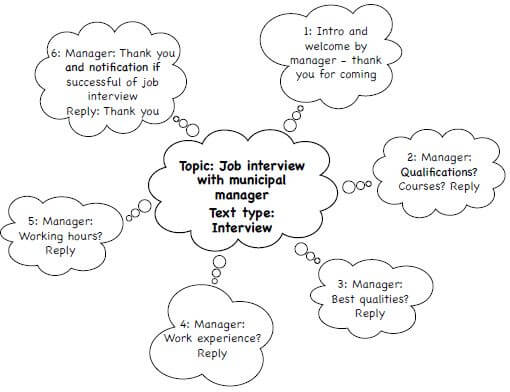
Step 3: Write and edit a draft text
Write a draft of the text using the ideas from the plan. Edit the draft by correcting any grammar, punctuation, spelling and format errors.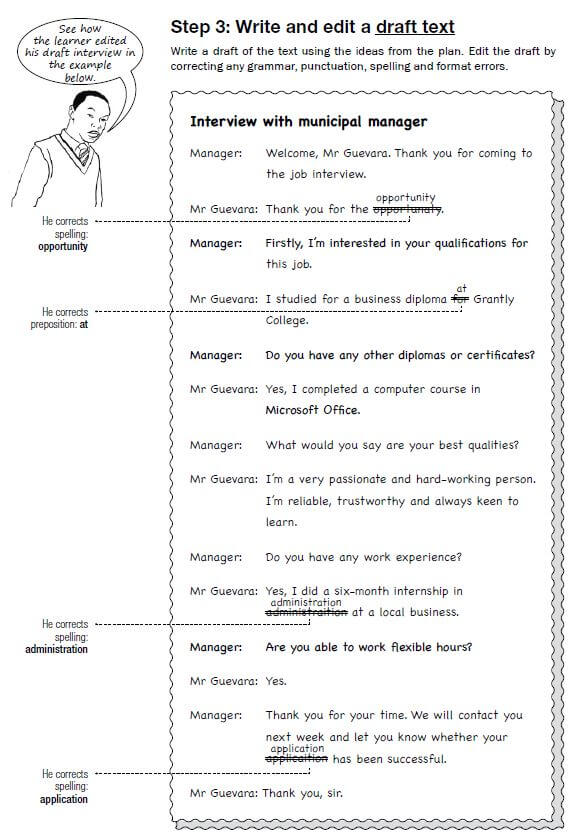
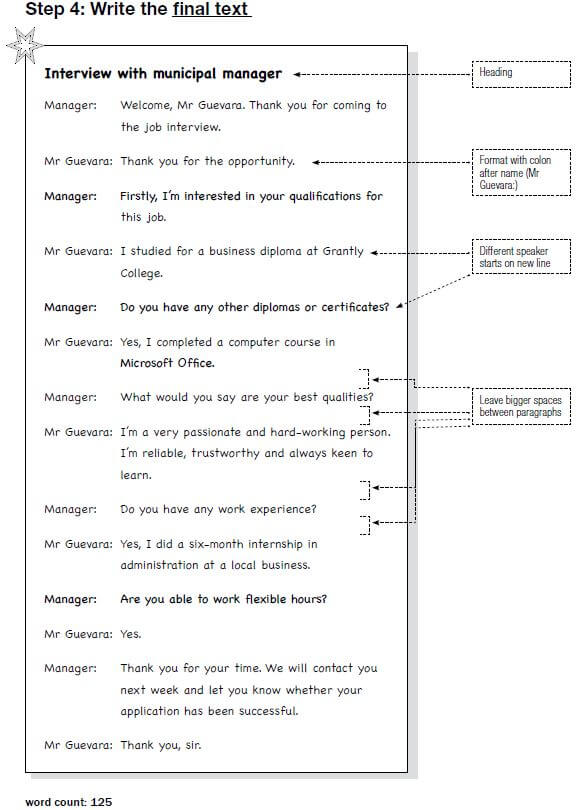
Activity: Writing an interview
Here are some topics to help you to practise writing interviews:
- You have applied for a bursary from a government department to study at a tertiary institution. The director of this department has called you for an interview.
Write down the interview that takes place between you and the director.
NOTE: Use the dialogue format. - You work for a local newspaper and your editor asks you to interview a well-known TV actor who lives near you. Write down the interview that takes place between you and the actor.
NOTE: Use the dialogue format.
5.4 Interview checklist
Features | Details of the feature | Yes | No | Don't know |
Text type | I understand the features of an interview. | |||
Topic | I understand the topic I have chosen. | |||
Content, planning and format | ||||
Planning | I can show evidence of planning. | |||
Content | Each point in plan is relevant to my topic. | |||
Purpose / Audience | I understand the purpose of an interview. | |||
Format | My interview is correctly laid out:
| |||
Language, style and editing | ||||
Choice of words / diction | I have chosen my words carefully to make interview interesting and life-like. | |||
Language | I have checked and corrected my grammar, spelling and punctuation. | |||
5.5 Writing a speech
A speech is a formal talk given to a group of people about a particular subject.
Hint:
|
eg: A learner’s example of a speech using the four steps
Step 1: Choose the text type
This learner chose this question on a speech:
You have been selected to deliver a farewell speech on behalf of the Grade 12 learners at your final school assembly.
Write out your speech.
Step 2: Plan the text
Read the question carefully. Note the key words in this topic are farewell speech and final school assembly.
This learner used a mind map to plan her speech.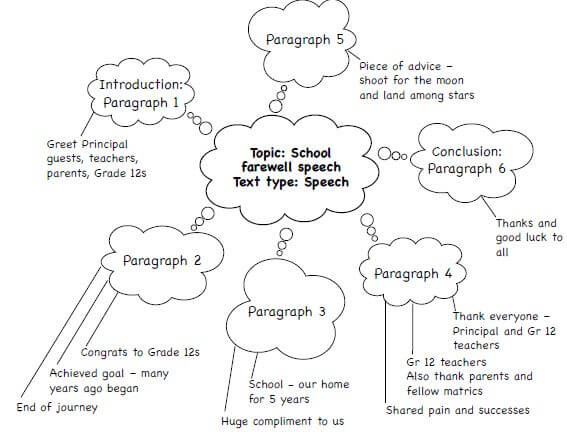
Step 3: Write and edit a draft text
Write a draft of the text using the ideas from the plan. Edit the draft by correcting any grammar, punctuation, spelling and format errors.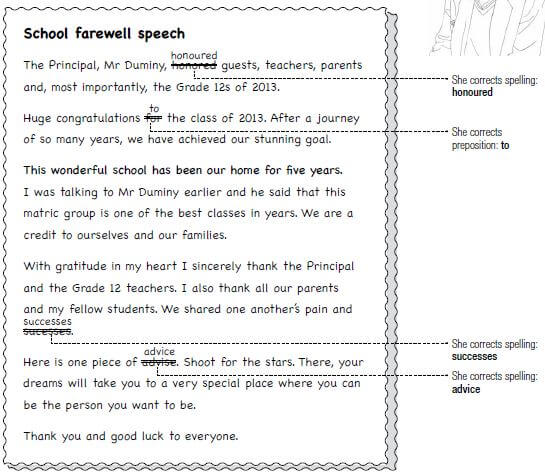
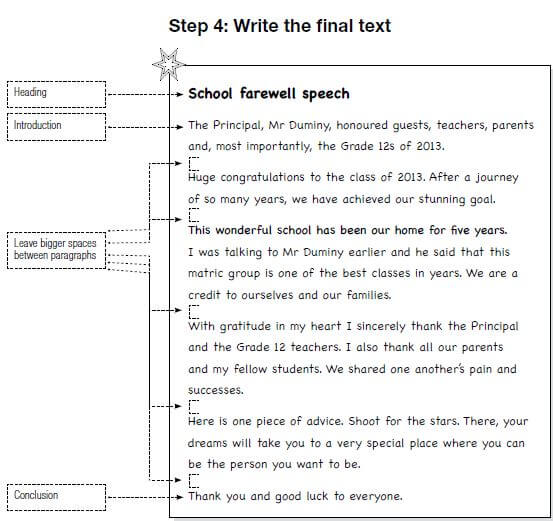
Activity: Writing a speech
Here are some topics to help you to practise writing speeches:
- A well-liked and respected Grade 12 teacher is leaving in the middle of the year. Your principal has asked you to deliver a farewell speech at the end-of-term assembly. Write this speech.
- You are the captain of a school sports team. The team has done well, thanks to a good coach. A function has been organised to celebrate the achievements of the team, and you have been asked to give a speech. Write this speech.
- A famous person is due to visit your school to deliver a motivational speech. Write the speech that will introduce this person to the school.
5.6 Speech checklist
Features | Details of the feature | Yes | No | Don't know |
Text type | I understand the features of a speech. | |||
Topic | I understand the topic I have chosen. | |||
Content, planning and format | ||||
Planning | I can show evidence of planning. | |||
Content | Each point in plan is relevant to my topic. | |||
Purpose / Audience | I understand the purpose of a speech. | |||
Format | My speech is correctly laid out:
| |||
Language, style and editing | ||||
Choice of words / diction | I have chosen my words carefully to make my speech interesting. | |||
Language | I have checked and corrected my grammar, spelling and punctuation. | |||
6. What is expected from you in the exam?
In the exam, you must write one longer transactional text that is no less than 120 words long and no more than 150 words long.
The longer transactional text question is worth 30 marks out of 100 marks in the exam. Examiners will give marks for your longer transactional text based on:
- Content, planning and format (18 marks)
- Language, style and editing (12 marks)
The exam is 2 1/2 hours long and your should spend about 40 minutes on the longer transactional text question.
The rubric on the next page is a table the examiners use to mark your longer transactional text. It shows the five levels of achievement that the examiners can award a longer transactional text, from the lowest achievement (Inadequate column) to the highest achievement (Exceptional column).
The table also describes the skills the examiner looks for when marking. For example, when marking the text, the examiner will assess how well the ideas relate to the topic, whether they are well planned, and that the format used is correct for the text type.
The rubric is a useful guide for you to use when practising your longer transactional text writing because it reminds you of the skills the examiner will be assessing
when marking your work.
ASSESSMENT RUBRIC FOR LONGER TRANSACTIONAL TEXT – FIRST ADDITIONAL LANGUAGE [30 MARKS]
| Criteria | Exceptional | Skillful | Moderate | Elementary | Inadequate |
| CONTENT, PLANNING & FORMAT Response and ideas; Organisation of ideas for planning; Purpose, audience, features/conventions and context 18MARKS | 15-18 | 11-14 | 8-10 | 5-7 | 0-4 |
|
|
|
|
| |
| LANGUAGE, STYLE & EDITING Tone, register, style, purpose/effect, audience and context; Language use and conventions; Word choice; Punctuation and spelling 12 MARKS | 10-12 | 8-9 | 6-7 | 4-5 | 0–3 |
|
|
|
|
| |
| MARK RANGE | 25-30 | 19-23 | 14-17 | 9-12 | 0-7 |